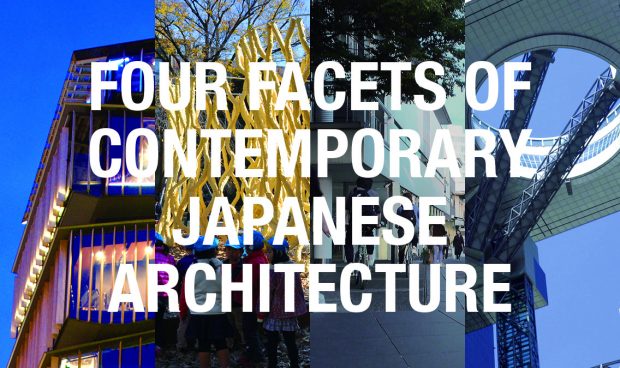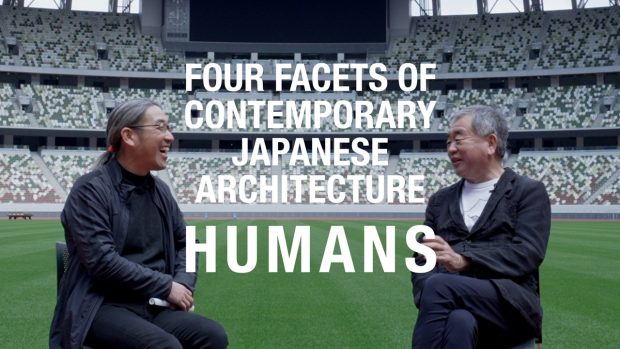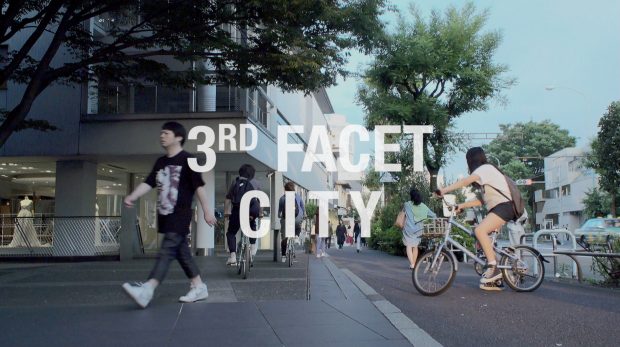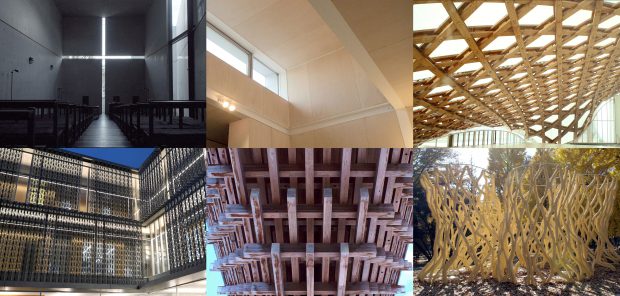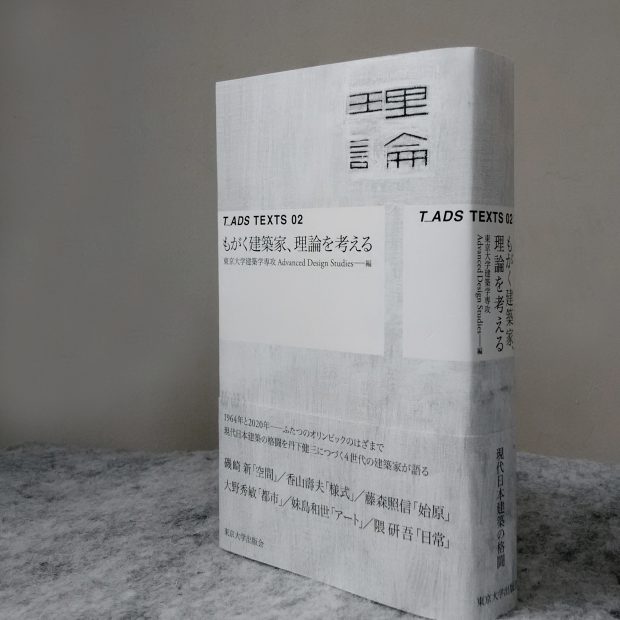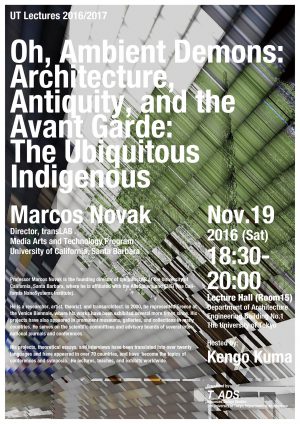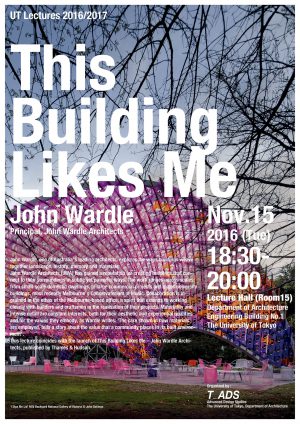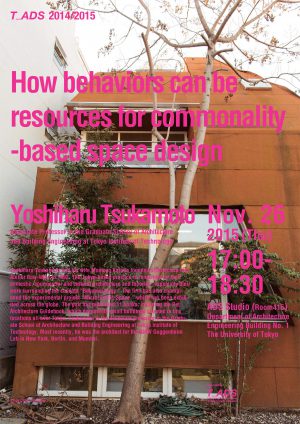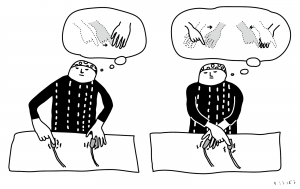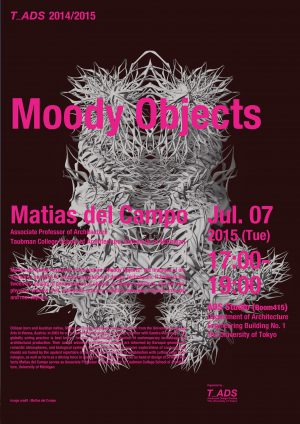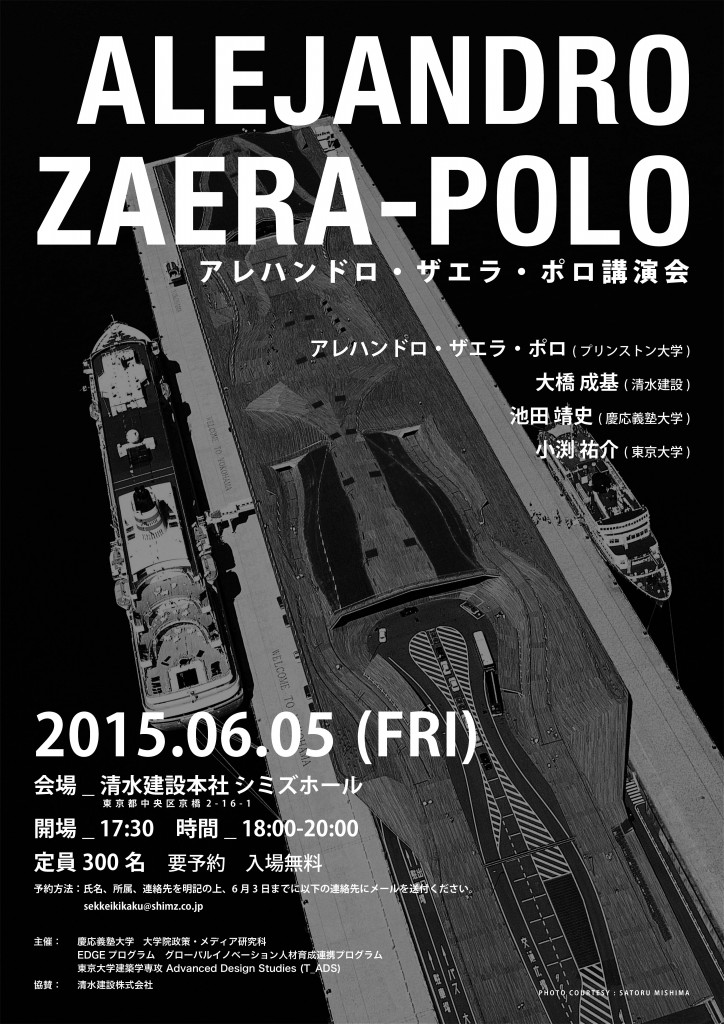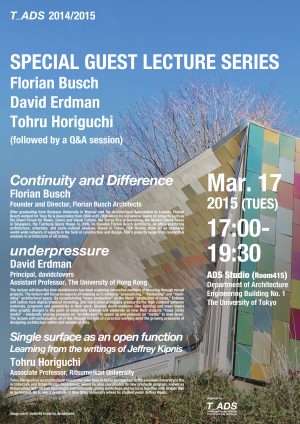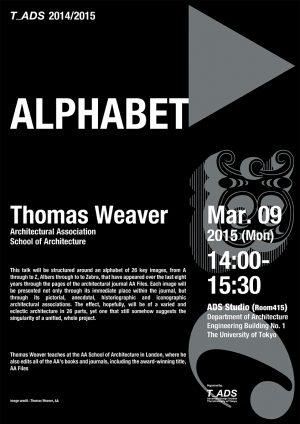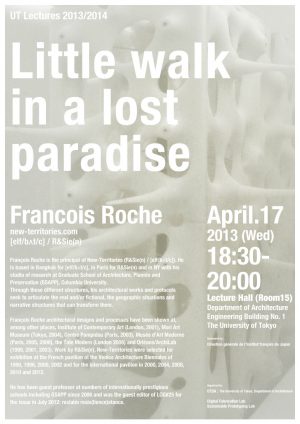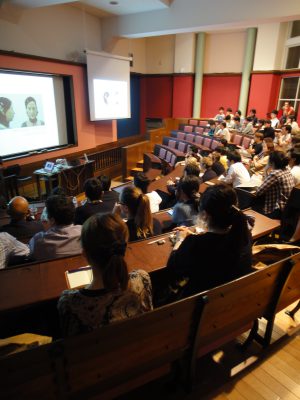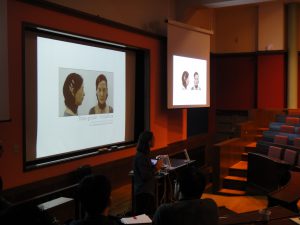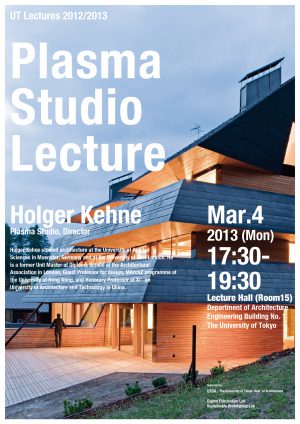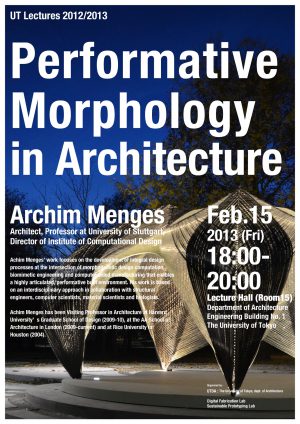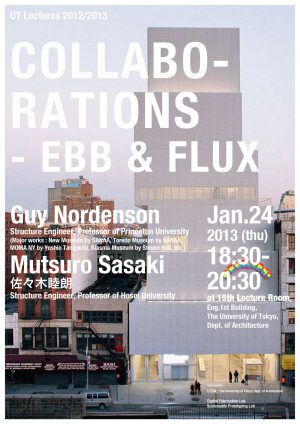Four Facets of Contemporary Japanese Architecture XSeries Program has started at edX.
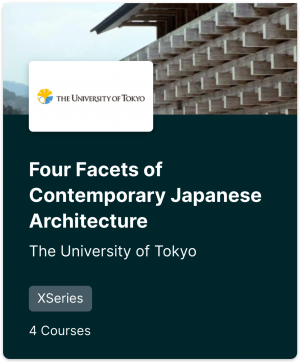
In this XSeries, you can take all four courses in the “Four Facets of Contemporary Japanese Architecture” series: “1st Facet: Theory,” “2nd Facet: Technology,” “3rd Facet: City,” and “4th Facet: Humans”. In the paid course [Verified Track], you will receive a certificate of completion by answering comprehension quizzes, but you can also view all lecture videos in the free course [Audit Track].
In this series, we have looked back on the turbulent half-century since Japan’s reconstruction after World War II, focusing on the four facets of architecture, together with the architects involved. We hope that many people will find it useful as a resource for considering the future of architecture and humanity.
Contents
FOUR FACETS OF CONTEMPORARY JAPANESE ARCHITECTURE: Theory1-1. Revisiting Kenzo Tange, Yoyogi 1st Gymnasium (1964)1-2. In Search of a Space – Arata Isozaki, The Museum of Modern Art, Gunma (1974)1-3. Learning from Style – Hisao Kohyama, Sainokuni Saitama Arts Theater (1994)1-4. New Primitivism – Terunobu Fujimori, La Collina Omihachiman (2014)1-5. Connecting the Dots – Hidetoshi Ohno, Heart Nursery School (2014)1-6. Architect without Architecture – Kengo Kuma, Asakusa Culture Tourist Information Center (2012)1-7. Too Large As Architecture Too Small As City – Kazuyo Sejima, Inujima “Art House Project” (2010-)1-8. Review – 1st Facet: Theory
FOUR FACETS OF CONTEMPORARY JAPANESE ARCHITECTURE: Technology2-1. Architecture Lives Inside People – Tadao Ando, Atelier in Oyodo II (1991)2-2. Advancing Systemic Spaces – Kazuhiko Namba, BOXHOUSE 112 (2006)2-3. What Do You Want, Wood? – Shigeru Ban, La Seine Musicale (2017)2-4. Why I Went to Countryside? – Kengo Kuma, Yusuhara Wooden Bridge Museum (2010)2-5. Design by Reinterpretation – Manabu Chiba, KOGAKUIN UNIVERSITY 125TH MEMORIAL EDUCATION CENTER (2012)2-6. In Praise of Errors – Yusuke Obuchi, DFL Pavilion (2015)2-7. Review – 2nd Facet: Technology
FOUR FACETS OF CONTEMPORARY JAPANESE ARCHITECTURE: City3-1. Architectures in Unconditional Love – Fumihiko Maki, Hillside Terrace (1969-1992)3-2. Architecture for the People – Itsuko Hasegawa, Niigata City Performing Arts Center (1998)3-3. Transparency: Literal & Behavioral – Riken Yamamoto, Saitama Prefectural University (1999)3-4. Worldly Architecture – Kengo Kuma, Nagaoka City Hall Aore (2012)3-5. Towards an Architecture of Emancipation – Jun Aoki, Omiyamae Gymnasium (2014)3-6. architecture After Architecture – Atelier Bow-Wow, Koisuru-Buta Laboratory (2012)3-7. Review – 3rd Facet: City
FOUR FACETS OF CONTEMPORARY JAPANESE ARCHITECTURE: Humans4-1. Architecture is Fiction – Hiroshi Hara, Hara House (1974)4-2. Constructing From Subconscious Images – Toyo Ito, Toyo Ito Museum of Architecture, Imabari (2011)4-3. Towards an Architecture of Interiority – Osamu Ishiyama, Gen An (1975)4-4. Living Room of the City – Kengo Kuma, V&A Dundee (2018)4-5. A House for Living Together – Satoko Shinohara, SHARE yaraicho (2012)4-6. Respect the World – Sou Fujimoto, SHIROIYA HOTEL (2020)4-7. Review – Kengo Kuma & Yusuke Obuchi, Japan National Stadium (2019)
Online courses from The University of Tokyo: https://www.edx.org/school/utokyoxIntroduction Page on the T—ADS Website: https://t-ads.org/mooc
オンライン講座「現代日本建築の四相—二つのオリンピックの狭間で」Xシリーズ スタート

このXシリーズでは、オンライン講座「現代日本建築の四相」シリーズの4つの講座「第一相:理論」「第二相:技術」「第三相:都市」「第四相:人間」のすべてを受講できます。有料コースでは、理解度を試すクイズに答えることで修了証を受けられますが、無料コースでも、すべての講義映像を視聴できます。
このシリーズでは、戦後の高度成長から現在にいたる日本の激動の半世紀を、建築の四つの相に着目して、その当事者であった建築家とともに振り返ってきました。ぜひ、これからの建築と人間の進む道を考えるための資料として、多くの方に役立てていただけることを願っています。
出演建築家
第一相:理論磯崎新、香山壽夫、藤森照信、大野秀敏、隈研吾、妹島和世
第二相:技術安藤忠雄、難波和彦、坂茂、隈研吾、千葉学、小渕祐介
第三相:都市槇文彦、長谷川逸子、山本理顕、隈研吾、青木淳、アトリエ・ワン(塚本由晴・貝島桃代)
第四相:人間原広司、伊東豊雄、石山修武、隈研吾、篠原聡子、藤本壮介
edXの東京大学サイト:https://www.edx.org/school/utokyoxT—ADS内の紹介ページ:https://t-ads.org/mooc
Free Online CourseFOUR FACETS OF CONTEMPORARY JAPANESE ARCHITECTURE — BETWEEN TWO OLYMPICSFourth Facet: Humans
Course Page on edX: Four Facets of Contemporary Japanese Architecture: Humans
Economic miracle, environmental problems, bubble economy and its collapse, information technology and globalization, earthquakes, population decline, pandemic… The nearly 60 years between the two Tokyo Olympics, 1964 and 2021, was a turbulent time for humans in Japan. During this period, how has architecture changed? And what happened to humans that architecture was supposed to have supported?
This course on “Humans” will review the works of those architects who have attempted to conceptualize humans through their architecture and examine the changes over the last half century as well as the issues for the future. Hiroshi Hara, Toyo Ito, Osamu Ishiyama, Kengo Kuma, Satoko Shinohara, and Sou Fujimoto visit their buildings to discuss the ideas behind their respective works.
Course Contents1. Architecture is Fiction – Hiroshi Hara, Hara House (1974)2. Constructing From Subconscious Images – Toyo Ito, Toyo Ito Museum of Architecture, Imabari (2011)3. Towards an Architecture of Interiority – Osamu Ishiyama, Gen An (1975)4. Living Room of the City – Kengo Kuma, V&A Dundee (2018)5. A House for Living Together – Satoko Shinohara, SHARE yaraicho (2012)6. Respect the World – Sou Fujimoto, SHIROIYA HOTEL (2020)7. Review – Kengo Kuma & Yusuke Obuchi, Japan National Stadium (2019)
This course is the fourth in the series, following “First Facet: Theory,” “Second Facet: Technology,” and “Third Facet: City,” which are currently open to the public.
Free online courses from The University of Tokyo: https://www.edx.org/school/utokyox
Introduction Page on the T—ADS Website: https://t-ads.org/mooc
無料オンラインコース現代日本建築の四相 — 二つのオリンピックの狭間で第四相:人間
オンライン講座(MOOC)プラットフォーム edX より公開Four Facets of Contemporary Japanese Architecture: Humans
高度成長、環境問題、バブル景気とその崩壊、情報化とグローバリズム、震災、人口減少、パンデミック… 1964年と2021年、2回の東京オリンピックの間の日本の約60年間は、人間をとりまく状況が大きく変化した激動の時代でした。この期間に、建築はどう変わったのでしょうか? また、建築が支えていたはずの人間はどうなったのでしょうか? 「人間」をテーマにした今回の講座では、この激動の期間を振り返りながら、建築と人間の現在と未来について考えます。
出演建築家:原広司、伊東豊雄、石山修武、隈研吾、篠原聡子、藤本壮介
このコースは、公開中の「第一相:理論」、「第二相:技術」、「第三相:都市」につづく第四弾です。
edXの東京大学サイト:https://www.edx.org/school/utokyox
T—ADS内の紹介ページ:https://t-ads.org/mooc
Intro Videos
Free Online CourseFOUR FACETS OF CONTEMPORARY JAPANESE ARCHITECTURE — BETWEEN TWO OLYMPICSThird Facet: City
Course page on edX: Four Facets of Contemporary Japanese Architecture: City
After the 1970s, Japanese architects are said to have stopped conceptualizing cities and instead focused on designing the individual buildings that make up the cities. However, as cities continue to undergo significant transformations in response to globalization, the advent of information technologies, and so on, Japanese architects are once again engaging the city, and doing so in unique ways.
This course on “City” will review the works of those architects who have attempted to conceptualize cities through their architecture and examine the changes over the last half century as well as the issues for the future. Fumihiko Maki, Itsuko Hasegawa, Riken Yamamoto, Kengo Kuma, Jun Aoki, and Atelier Bow-Wow (Yoshiharu Tsukamoto & Momoyo Kaijima) visit their buildings to discuss the ideas behind their respective works.
Course Contents1. Architectures in Unconditional Love – Fumihiko Maki, Hillside Terrace (1969-1992)2. Architecture for the People – Itsuko Hasegawa, Niigata City Performing Arts Center (1998)3. Transparency: Literal & Behavioral – Riken Yamamoto, Saitama Prefectural University (1999)4. Worldly Architecture – Kengo Kuma, Nagaoka City Hall Aore (2012)5. Towards an Architecture of Emancipation – Jun Aoki, Omiyamae Gymnasium (2014)6. architecture After Architecture – Atelier Bow-Wow, Koisuru-Buta Laboratory (2012)7. Review – 3rd Facet: City
This course is the fourth in the series, following “First Facet: Theory,” and “Second Facet: Technology,” which are currently open to the public.
Free online courses from The University of Tokyo: https://www.edx.org/school/utokyox
Introduction Page on the T—ADS Website: https://t-ads.org/mooc
無料オンラインコース 現代日本建築の四相 — 二つのオリンピックの狭間で 第三相:都市
オンライン講座(MOOC)プラットフォーム edX より公開中Four Facets of Contemporary Japanese Architecture: City
広島ピースセンター(1955)、東京計画1960、東京オリンピック(1964)、大阪万博(1970)など、1950年代から60年代において、建築家丹下健三は、数多くの都市的プロジェクトに携わりました。しかし、1970年代以降の日本では、大規模プロジェクトの減少とともに、建築家たちは都市の構想から撤退し、個々の建物の設計に専念するようになったとも言われます。しかし現在、グローバリズムや情報技術の進歩などによって都市の概念すら変わりつつあるなか、建築家たちは再び都市と向き合い、独自の方法で活動を繰り広げています。第三相「都市」では、建築から都市を考えることを継続してきた現代建築家の活動を振り返りながら、この半世紀の間に何が変わったのか、これからの課題とともに考えます。
出演建築家:槇文彦、長谷川逸子、山本理顕、隈研吾、青木淳、アトリエ・ワン
このコースは、公開中の「第一相:理論」、「第二相:技術」につづく第三弾です。
edXの東京大学サイト:https://www.edx.org/school/utokyox
T—ADS内の紹介ページ:https://t-ads.org/mooc
Intro Videos
無料オンラインコース「現代日本建築の四相 第一相:理論」が、2018年 日本建築学会教育賞(教育貢献)を受賞しました。
日本建築学会URL : https://www.aij.or.jp/2018/2018prize.html
Free Online Course “FOUR FACETS OF CONTEMPORARY JAPANESE ARCHITECTURE : Theory “ won the Prize of AIJ (Architectural Institute of Japan) for Education Award for Outstanding Practice.
Architectural Institute of Japan URL : https://www.aij.or.jp/eng/prizes/prize/prize18.html
Free Online CourseFOUR FACETS OF CONTEMPORARY JAPANESE ARCHITECTURE — BETWEEN TWO OLYMPICSSecond Facet: Technology
Course Page on edX: Four Facets of Contemporary Japanese Architecture: Technology
This is the second course of architecture series. We will focus on works by architects who explored the use of technology—from techniques used for traditional crafts to computational processes—as a vehicle for their investigations into the conceptualization and production of architecture. Tadao Ando, Kazuhiko Namba, Shigeru Ban, Manabu Chiba, Kengo Kuma, and Yusuke Obuchi will visit their buildings to discuss the ideas behind their respective works.
Course Contents1. Architecture Lives Inside People – Tadao Ando, Atelier in Oyodo II (1991)2. Advancing Systemic Spaces – Kazuhiko Namba, BOXHOUSE 112 (2006)3. What Do You Want, Wood? – Shigeru Ban, La Seine Musicale (2017)4. Why I Went to Countryside? – Kengo Kuma, Yusuhara Wooden Bridge Museum (2010)5. Design by Reinterpretation – Manabu Chiba, KOGAKUIN UNIVERSITY 125TH MEMORIAL EDUCATION CENTER (2012)6. In Praise of Errors – Yusuke Obuchi, DFL Pavilion (2015)7. Review – 2nd Facet: Technology
This course is the second in the series following “First Facet: Theory,” and is followed by “Third Facet: City” and “Fourth Facet: Humans.”
Free online courses from The University of Tokyo: https://www.edx.org/school/utokyox
Introduction Page on the T—ADS Website: https://t-ads.org/mooc
無料オンラインコース 現代日本建築の四相 — 二つのオリンピックの狭間で 第二相:技術
オンライン講座(MOOC)プラットフォーム edX より公開中Four Facets of Contemporary Japanese Architecture: Technology
現代日本建築の発展において、技術はどのような意味を持っていたのか? それは、今後どのように変わっていくのか? 6人の建築家と彼らの代表作で行われた対話から探ります。
出演建築家:安藤忠雄、難波和彦、坂茂、隈研吾、千葉学、小渕祐介
このコースは、現在公開中の 「第一相:理論」につづくシリーズ第二弾で、「第三相:都市」、「第四相:人間」に続きます。
edXの東京大学サイト:https://www.edx.org/school/utokyox
T—ADS内の紹介ページ:https://t-ads.org/mooc
Intro Videos
建築の理論について考える書籍シリーズ T_ADS TEXTS の第2号、『T_ADS TEXTS 02 もがく建築家、理論を考える』が、6月30日に東京大学出版会より出版されます。
今号は、隈研吾と小渕祐介が講師をつとめる国際オンライン講義「現代日本建築の四相 第一相:理論」Four Facets of Contemporary Japanese Architecture: Theory をまとめたもので、現代日本建築を「理論」から理解する格好の入門書になっています。
図版をふんだんに使い、オンライン講座を見た方も見ていない方も楽しめる内容になっています。ぜひお手にとってご覧ください!
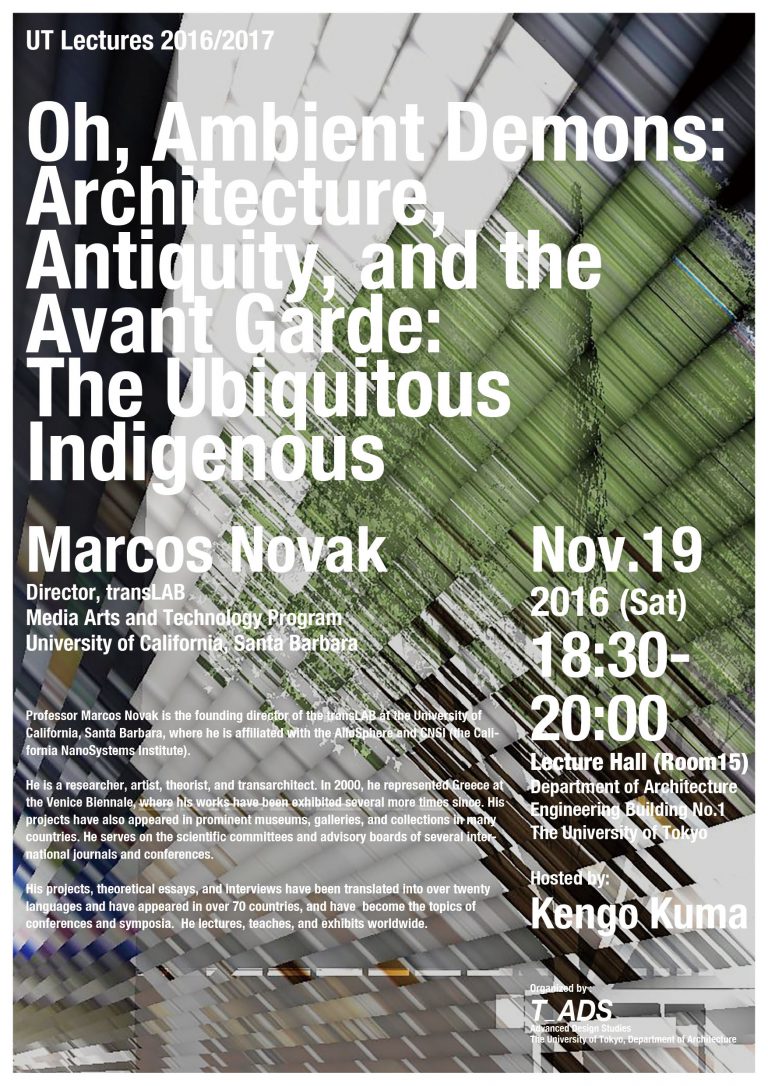
Lecture: Oh, Ambient Demons: Architecture, Antiquity, and the Avant Garde: The Ubiquitous Indigenous
Speaker: Marcos Novak, Director, TransLAB, Media Arts and Technology Program, University of California, Santa Barbara
November 19, 2016 (Saturday)
18:30-20:00
Professor Marcos Novak is the founding director of the transLAB at the University of California, Santa Barbara, where he is affiliated with the AlloSphere and CNSI (the California NanoSystems Institute).
He is a researcher, artist, theorist, and transarchitect. In 2000, he represented Greece at the Venice Biennale, where his works have been exhibited several more times since. His projects have also appeared in prominent museums, galleries, and collections in many countries. He serves on the scientific committees and advisory boards of several international journals and conferences.
His projects, theoretical essays, and interviews have been translated into over twenty languages, have appeared in over 70 countries, and have, and have become the topics of conferences and symposia. He lectures, teachers, and exhibits worldwide.
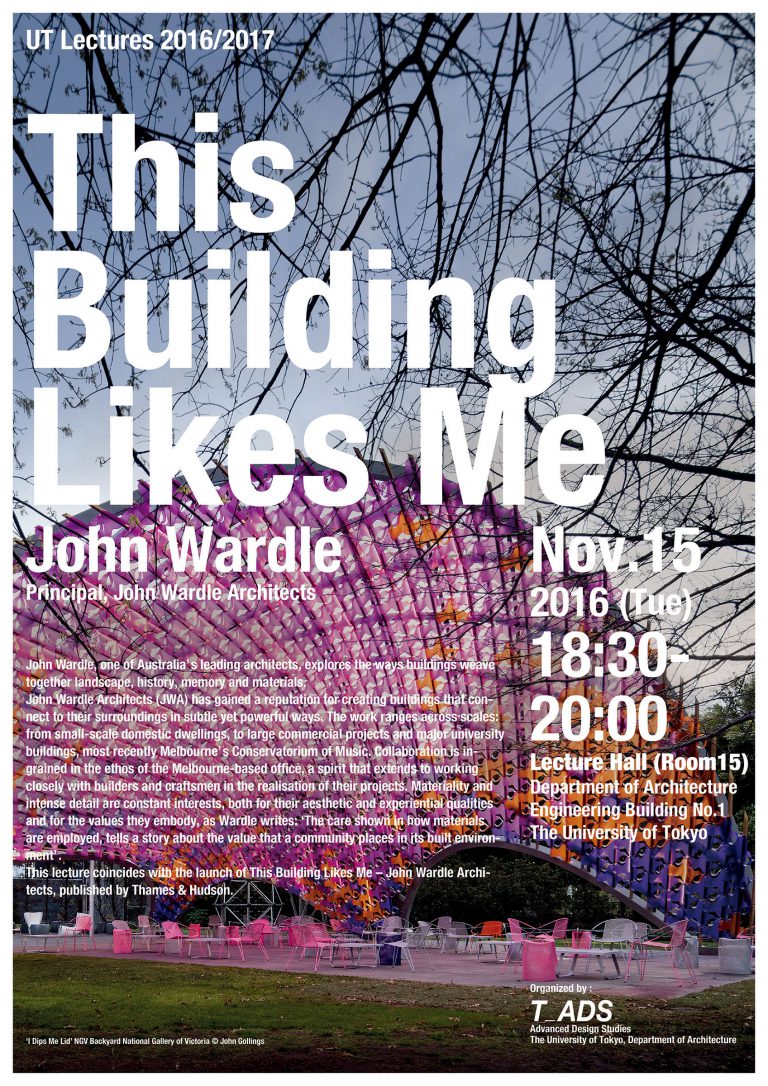
Lecture: This Building Likes Me
Speaker: John Wardle
November 15, 2016 (Tuesday)
18:30-20:00
John Wardle, one of Australia’s leading architects, explores the ways buildings weave together landscape, history, memory, and materials.
John Wardle Architects (JWA) has gained a reputation for creating buildings that connect to their surroundings in subtle yet powerful ways. The work ranges across scales: from small-scale domestic dwellings, to large commercial projects and major university buildings, most recently, Melbourne’s Conservatorium of Music. Collaboration is ingrained in the those of the Melbourne-based office, a spirit that extends to working closely with builders and craftsmen in the realization of their projects. Materiality and intense detail are constant interests, both for their aesthetic and experiential qualities and for the values they embody, as Wardle writes: “The care shown in how materials are employed, tells a story about the value that a community places in its built environment.”
This lecture coincides with the launch of This Building Likes Me – John Wardle Architects, published by Thames Hudson
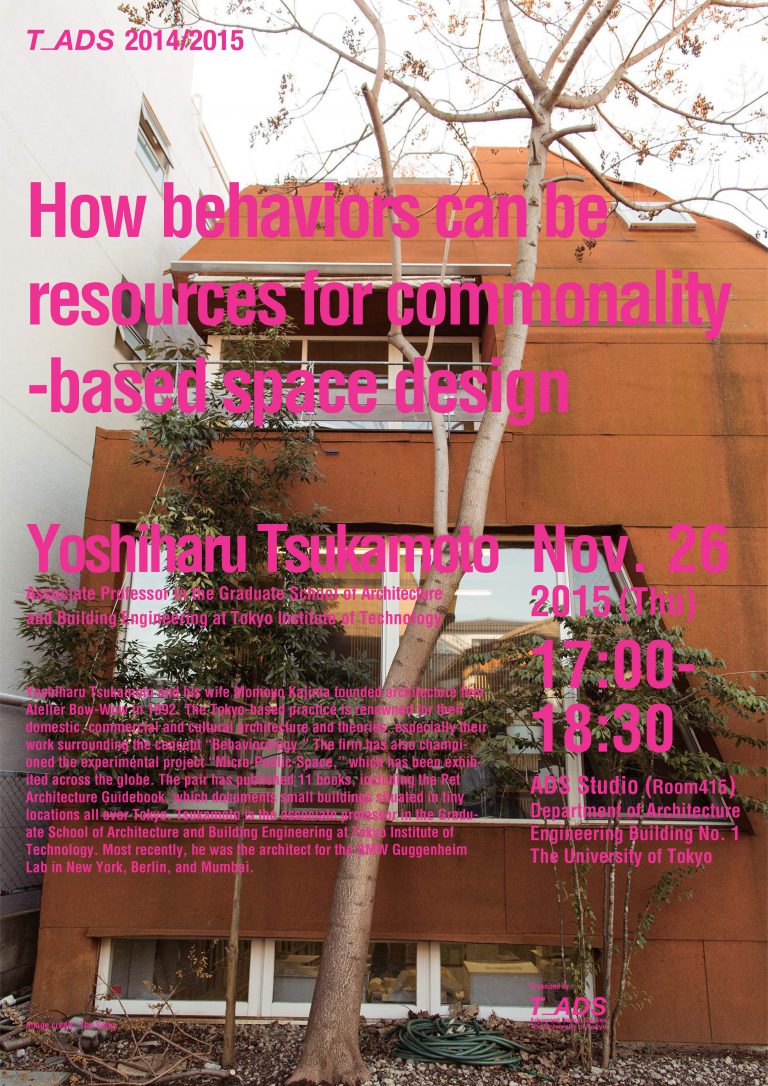
Lecture: How Behaviors can be Resources for Commonality-based Space Design
Speaker: Yoshiharu Tsukamoto, Associate Professor of the Graduate School of Architecture and Building at Tokyo Institute of Technology
November 26, 2015 (Thursday)
17:00-18:30
Yoshiharu Tsukamoto and his wife Momoyo Kajima founded architecture firm Atelier Bow-Wow in 1992. The Tokyo-based practice is renowned for their domestic, commercial and cultural architecture and theories, especially their work surrounding the concept “Behaviorology.” The firm has also championed the experimental project “Micro-Public-Space,” which has been exhibited across the globe. The pair has published 11 books, including the Pet Architecture Guidebook, which documents small buildings situated in tiny locations all over Tokyo. Tsukamoto is the associate professor in the Graduate School of Architecture and Building Engineering at Tokyo Institute of Technology. Most recently, he was the architect for the BMW Guggenheim Lab in New York, Berlin, and Mumbai.
T_ADS + Shinkenchiku Lecture Series #02
Kenri Kodaka |
Body-image reconstruction based on the principle of the body ownership illusion.
Date
August 28 (FRI) 18:00-20:00 (Opens from 17:30, Free admission)
Location
U-Tokyo Faculty of Engineering Bldg.1 LectureRoom 15
Lecturer
Kenri Kodaka
Born in 1979. Received Ph.D. in Engineering from WABOT-HOUSE Laboratory, Waseda University, after graduating from the Faculty of Integrated Humanities at Kyoto University and IAMAS (Institute of Advanced Media Arts and Sciences). In 2012, became an associate professor at the Nagoya City University School of Design and Architecture, Graduate School of Design and Architecture. Research focuses on physical misperceptions. Received many awards, such as the Best Paper Award at IPSJ2005, selected for Ask? Film Festival 2007, Best Paper Award in Robotics at IEEE/SICE SII2011, and Interactive Presentation Award at Interaction 2015.
Language
English
Sponser
U-Tokyo Advanced Design Studies (T_ADS)
Shinkenchiku
—
T_ADS + 新建築社 レクチャーシリーズ第二回
小鷹研理 |
錯覚原理を足場に構想する、<からだ>のリコンストラクション
日時
2015年8月28日(金) 18:00 – 20:00(開場17:30)
場所
東京大学本郷キャンパス工学部一号館 15号教室
講師
小鷹 研理
1979年生まれ。京都大学総合人間学部卒業後、京都大学情報学研究科・IAMASを経て、早稲田大学WABOT-HOUSE研究所で博士(工学)を取得。2012年より現職(名古屋市立大学芸術工学研究科・准教授)。主にからだの錯覚に関する研究に従事。大会論文賞(IPSJ2005)、入選(Ask?映像祭2007)、BEST PAPER AWARD ROBOTICS(IEEE/SICE SII2011)、インタラクティブ発表賞(インタラクション2015)等受賞。
言語
英語
主催
東京大学建築学専攻 Advanced Design Studies (T_ADS)
新建築社
T_ADS + Shinkenchiku Lecture Series #01
Keita Watanabe |
Interface design in the Post-Internet Age
Date
August 26th (Wed) 18:00-20:00 (Opens from 17:30, Free admission)
Location
U-Tokyo Faculty of Engineering Bldg.1 #415
Lecturer
Keita Watanabe
Born in 1981. A lecturer at the Meiji University’s Department of Frontier Media Science, School of Interdisciplinary Mathematical Sciences. The President and CEO of Cidre Interaction Design. Received Ph.D. in Media and Governance from Keio University, Graduate School of Media and Governance. Researches interactive methods for interface and internet designs based on perception and corporeality. Recently published “融けるデザイン ハードxソフトxネットの時代の新たな設計論” (BNN, Inc., 2015).
Language
Japanese / English(Realtime translation)
Sponser
U-Tokyo Advanced Design Studies (T_ADS)
Shinkenchiku
—
T_ADS + 新建築社 レクチャーシリーズ第一回
渡邊恵太 |
インターネット前提時代のインターフェースデザイン
日時
2015年8月26日(水) 18:00 – 20:00(開場17:30)
場所
東京大学本郷キャンパス工学部一号館 415号教室
講師
渡邊 恵太
1981年生まれ。明治大学総合数理学部 先端メデイアサイエンス学科専任講師。
シードルインタラクションデザイン株式会社代表取締役社長。 2009年慶應義塾
大学政策メディア研究科博士課程修了。博士(政策・メディア)。知覚や身体性
を活かしたインターフェイスデザインやネットを前提としたインタラクション
手法を研究。近著に『融けるデザイン ハードxソフトxネットの時代の新たな
設計論』(BNN新社、2015)。
言語
日本語 / 英語(同時通訳)
主催
東京大学建築学専攻 Advanced Design Studies (T_ADS)
新建築社
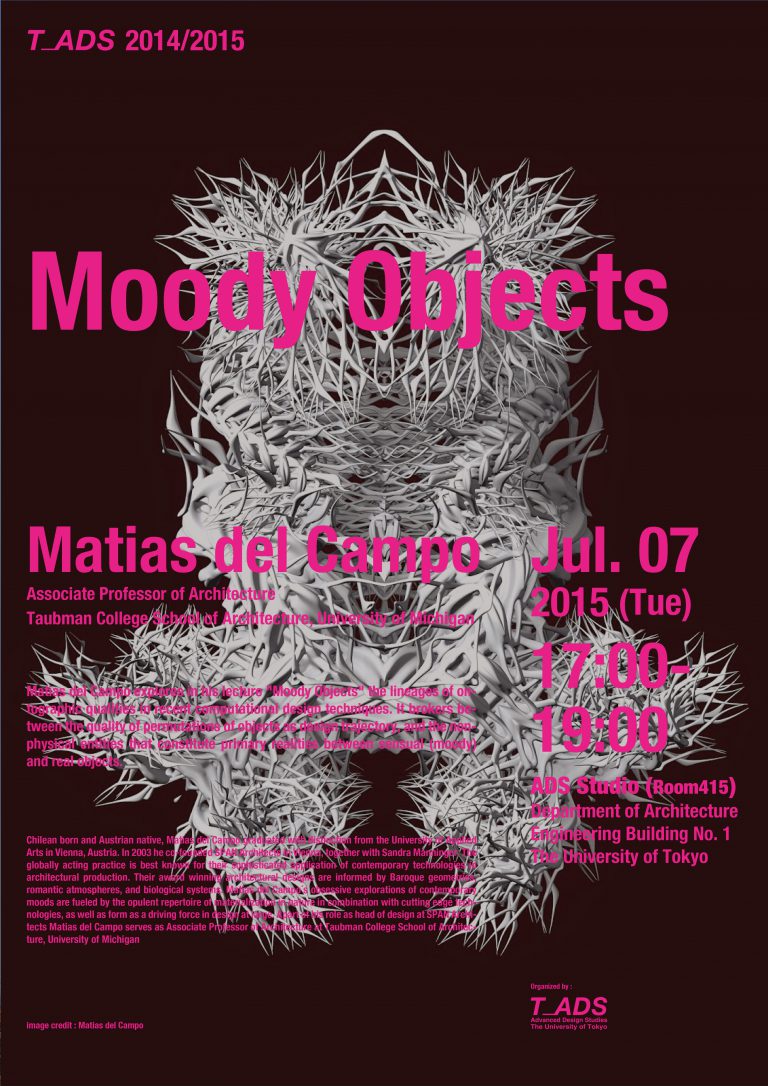
Lecture: Moody Objects
Speaker: Matias del Campo, Associate Professor of Architecture, Taubman College of Architecture, University of Michigan
July 7, 2015 (Tuesday)
17:00-19:00
Matias del Campo explores in his lecture “Moody Objects” the lineages of ontographic qualities in recent computational design techniques. It brokers between the quality of permutations of objects as design trajectory, and the non- physical entities that constitute primary realities between sensual (moody) and real objects.
Chilean born and Austrian native, Matias del Campo graduated with distinction from the University of Applied Arts in Vienna, Austria. In 2003 he co-founded SPAN Architects in Vienna, together with Sandra Manninger. The globally acting practice is best known for their sophisticated application of contemporary technologies in architectural production. Their award winning architectural designs are informed by Baroque geometries, romantic atmospheres, and biological systems. Matias del Campo ́s obsessive explorations of contemporary moods are fueled by the opulent repertoire of materialization in nature in combination with cutting edge technologies, as well as form as a driving force in design at large. Apart of his role as head of design at SPAN Architects Matias del Campo serves as Associate Professor of Architecture at Taubman College School of Architecture, University of Michigan
日時: 2015年6月5日(金)18:00 – 20:00(開場17:30)
場所:清水建設本社 シミズホール(東京都中央区京橋2-16-1)
定員: 300名(要予約 入場無料)
予約方法:氏名、所属、連絡先を明記の上、6月3日までに以下の連絡先にメールを送付ください。sekkeikikaku@shimz.co.jp
出演:アレハンドロ・ザエラ・ポロ(プリンストン大学)/大橋成基(清水建設)/池田靖史(慶応義塾大学)/小渕祐介(東京大学)
プリンストン大学教授で、横浜大さん橋を設計した建築家のアレハンドロ・ザエラ・ポロ氏の特別レクチャーをおこないます。6月6日(土)、7日(日)のイベントでは、Continuous Architectureという建築のアイディアを中心に議論がおこなわれるのに対し、本レクチャーは、横浜大さん橋という時代を象徴する建築自体にフォーカスを当てる予定です。予約制となりますが、ぜひご参加ください。
主催:慶応義塾大学大学院 政策・メディア研究科 EDGEプログラム グローバルイノベーション人材育成連携プログラム/東京大学建築学専攻 Advanced Design Studies (T_ADS)
協賛:清水建設株式会社
June 5 (FRI) 18:00-20:00
Shimizu Hall (2-16-1 Kyobashi, Chuo-ku, Tokyo)
(Opens from 17:30, 300 seats maximum, Free admission)
Prior booking essential: Please send an E-mail with your name, position, and contact to the following address by June 3. sekkeikikaku@shimz.co.jp
– Alejandro Zaera-Polo (Princeton University, AZPML)
– Naruki Ohashi (Shimizu Corporation)
– Yasushi Ikeda (Keio University)
– Yusuke Obuchi (The University of Tokyo)
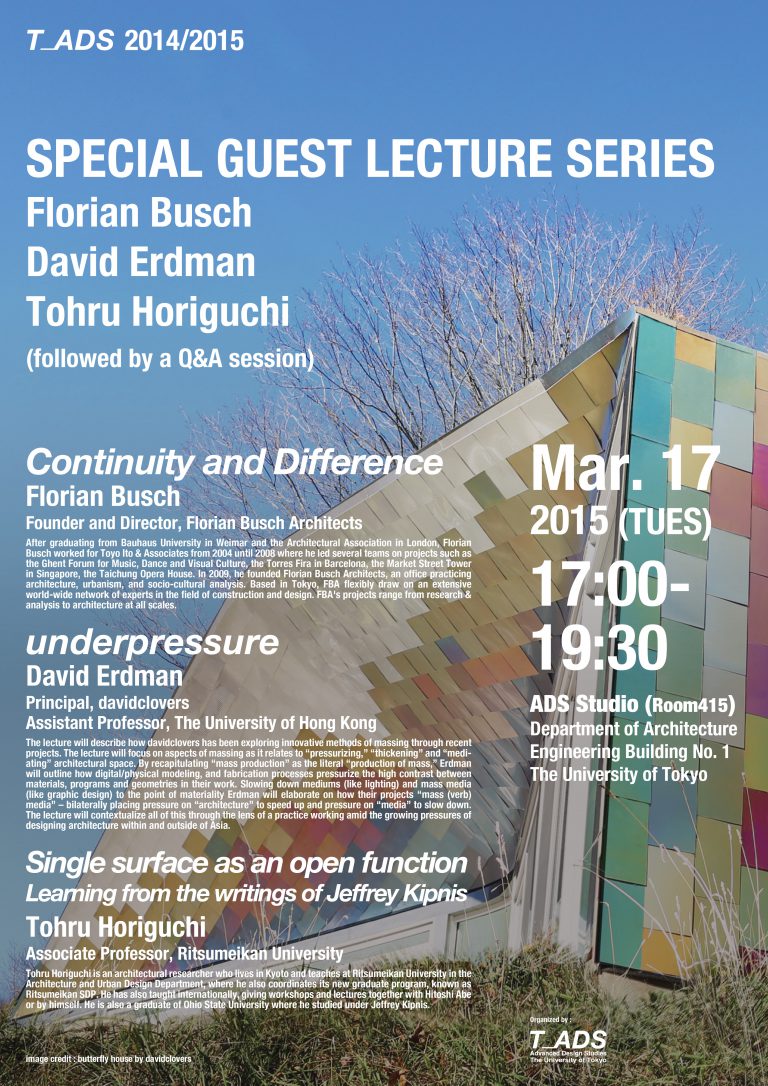
March 17, 2015 (Tuesday)
17:00-19:30
Special Guest Lecture Series
Florian Busch
David Erdman
Tohru Horiguchi
Continuity and Difference
Florian Busch
After graduating from Bauhaus University in Weimar and the Architectural Association in London, Florian Busch worked for Toyo Ito & Associates from 2004 until 2008 where he led several teams on projects such as the Ghent Forum for Music, Dance and Visual Culture, the Torres Fira in Barcelona, the Market Street Tower in Singapore, the Taichung Opera House. In 2009, he founded Florian Busch Architects, an office practicing architecture, urbanism, and socio-cultural analysis. Based in Tokyo, FBA flexibly draw on an extensive world-wide network of experts in the field of construction and design. FBA’s projects range from research & analysis to architecture at all scales.
underpressure
David Erdman
The lecture will describe how davidclovers has been exploring innovative methods of massing through recent projects. The lecture will focus on aspects of massing as it relates to “pressurizing,” “thickening” and “mediating” architectural space. By recapitulating “mass production” as the literal “production of mass,” Erdman will outline how digital/physical modeling, and fabrication processes pressurize the high contrast between materials, programs and geometries in their work. Slowing down mediums (like lighting) and mass media (like graphic design) to the point of materiality Erdman will elaborate on how their projects “mass (verb) media” – bilaterally placing pressure on “architecture” to speed up and pressure on “media” to slow down. The lecture will contextualize all of this through the lens of a practice working amid the growing pressures of designing architecture within and outside of Asia.
Single surface as an open function Learning from the writings of Jeffrey Kipnis
Tohru Horiguchi
Tohru Horiguchi is an architectural researcher who lives in Kyoto and teaches at Ritsumeikan University in the Architecture and Urban Design Department, where he also coordinates its new graduate program, known as Ritsumeikan SDP. He has also taught internationally, giving workshops and lectures together with Hitoshi Abe or by himself. He is also a graduate of Ohio State University where he studied under Jeffrey Kipnis.
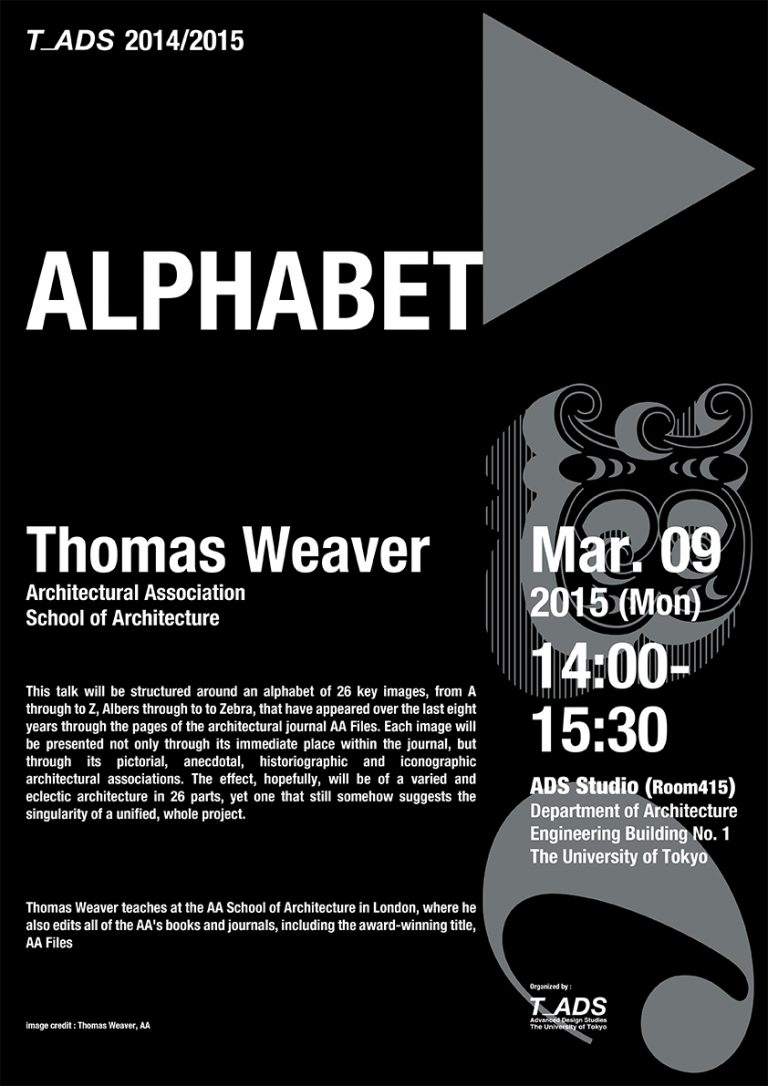
Lecture: Alphabet
Speaker: Thomas Weaver
Architectural Association, School of Architecture
March 9, 2015 (Monday)
14:00-15:30
This talk will be structured around an alphabet of 26 key images, from A through to Z, Albers through to to Zebra, that have appeared over the last eight years through the pages of the architectural journal AA Files. Each image will be presented not only through its immediate place within the journal, but through its pictorial, anecdotal, historiographic and iconographic architectural associations. The effect, hopefully, will be of a varied and eclectic architecture in 26 parts, yet one that still somehow suggests the singularity of a unified, whole project.
Thomas Weaver teaches at the AA School of Architecture in London, where he also edits all of the AA’s books and journals, including the award-winning title, AA Files
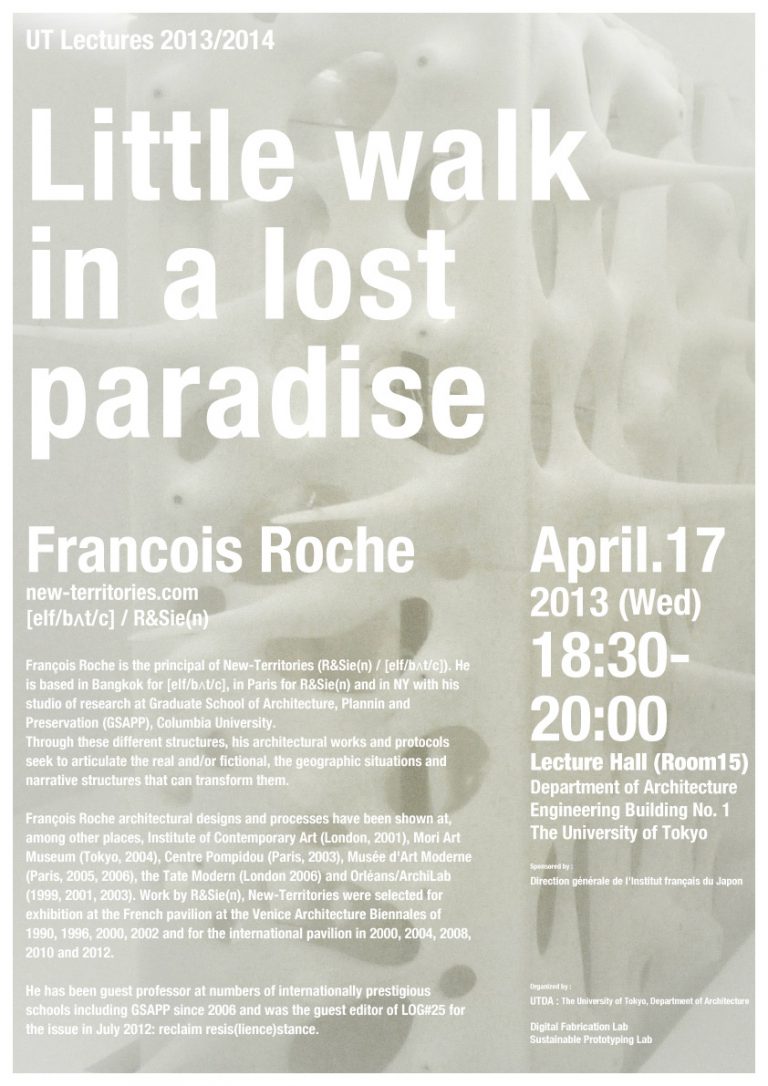
Lecture: Little Walk in a Lost Paradise
Speaker: Francois Roche
April 17, 2013
18:30-20:00
François Roche is the principal of New-Territories (R&Sie(n) / [eIf/bʌt/c]). He is based in Bangkok for [eIf/bʌt/c], in Paris for R&Sie(n) and in NY with his studio of research at Graduate School of Architecture, Plannin and Preservation (GSAPP), Columbia University.
Through these different structures, his architectural works and protocols seek to articulate the real and/or fictional, the geographic situations and narrative structures that can transform them.
François Roche architectural designs and processes have been shown at, among other places, Institute of Contemporary Art (London, 2001), Mori Art Museum (Tokyo, 2004), Centre Pompidou (Paris, 2003), Musée d’Art Moderne (Paris, 2005, 2006), the Tate Modern (London 2006) and Orléans/ArchiLab (1999, 2001, 2003). Work by R&Sie(n), New-Territories were selected for exhibition at the French pavilion at the Venice Architecture Biennales of 1990, 1996, 2000, 2002 and for the international pavilion in 2000, 2004, 2008, 2010 and 2012.
He has been guest professor at numbers of internationally prestigious schools including GSAPP since 2006 and was the guest editor of LOG#25 for the issue in July 2012: reclaim resi(lience)stance.
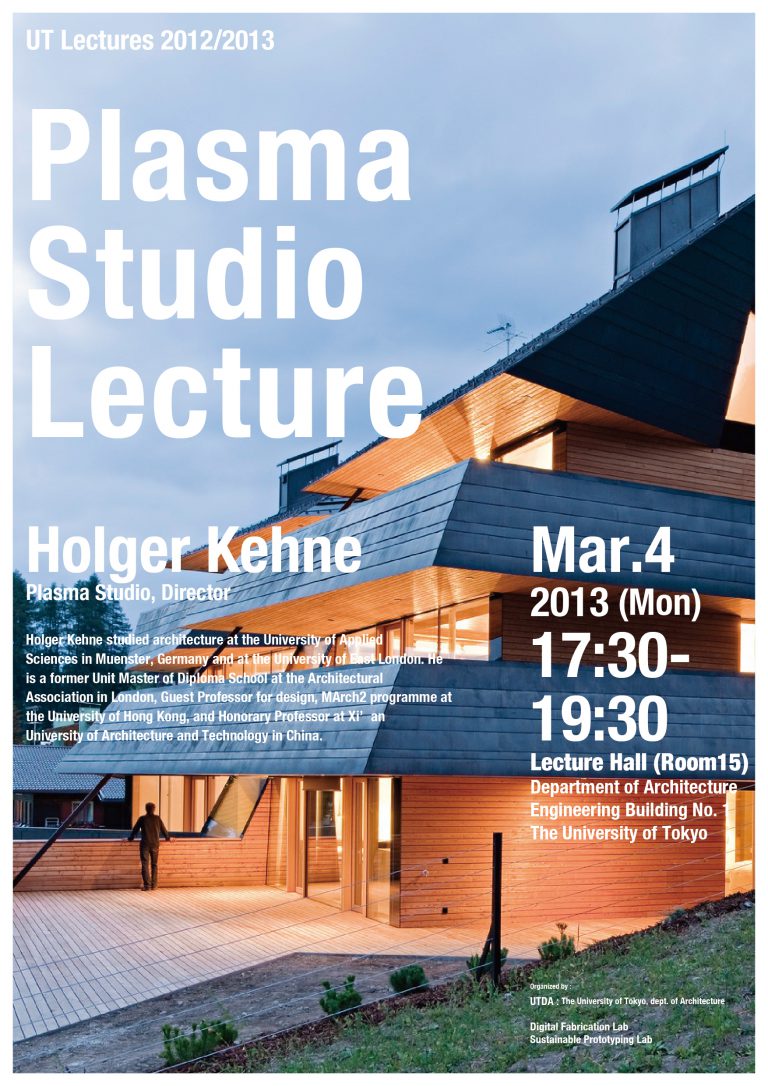
Lecture: Plasma Studio
Speaker: Holger Kehne, Director, Plasma Studio
March 4, 2013 (Monday)
17:30-19:30
Holger Kehne studied architecture at the University of Applied Sciences in Muenster, Germany and at the University of East London. He is a former Unit Master of Diploma School at the Architectural Association in London, Guest Professor for design, MArch2 programme at the University of Hong Kong, and Honorary Professor at Xi’ an University of Architecture and Technology in China.
Lecture: Performative Morphology in Architecture
Speaker: Achim Menges, Architect, Professor at University of Stuttgart, Director of Institute on Computational Design
February 15, 2013 (Friday)
18:00-20:00
Achim Menges’ work focuses on the development of integral design processes at the intersection of morphogenetic design computation, biomimetic engineering and computer aided manufacturing that enables a highly articulated, performative built environment. His work is based on an interdisciplinary approach in collaboration with structural engineers, computer scientists, material scientists and biologists.
Achim Menges has been Visiting Professor in Architecture at Harvard University’ s Graduate School of Design (2009-10), at the AA School of Architecture in London (2009-current) and at Rice University in Houston (2004).
Lecture: Collaborations – Ebb & Flux
Speakers: Guy Nordenson, Structural Engineer, Professor at Princeton University
Mutsuro Sasaki, Structural Engineer, Professor at Hosei University
January 24, 2013 (Thursday)
18:30-20:30

